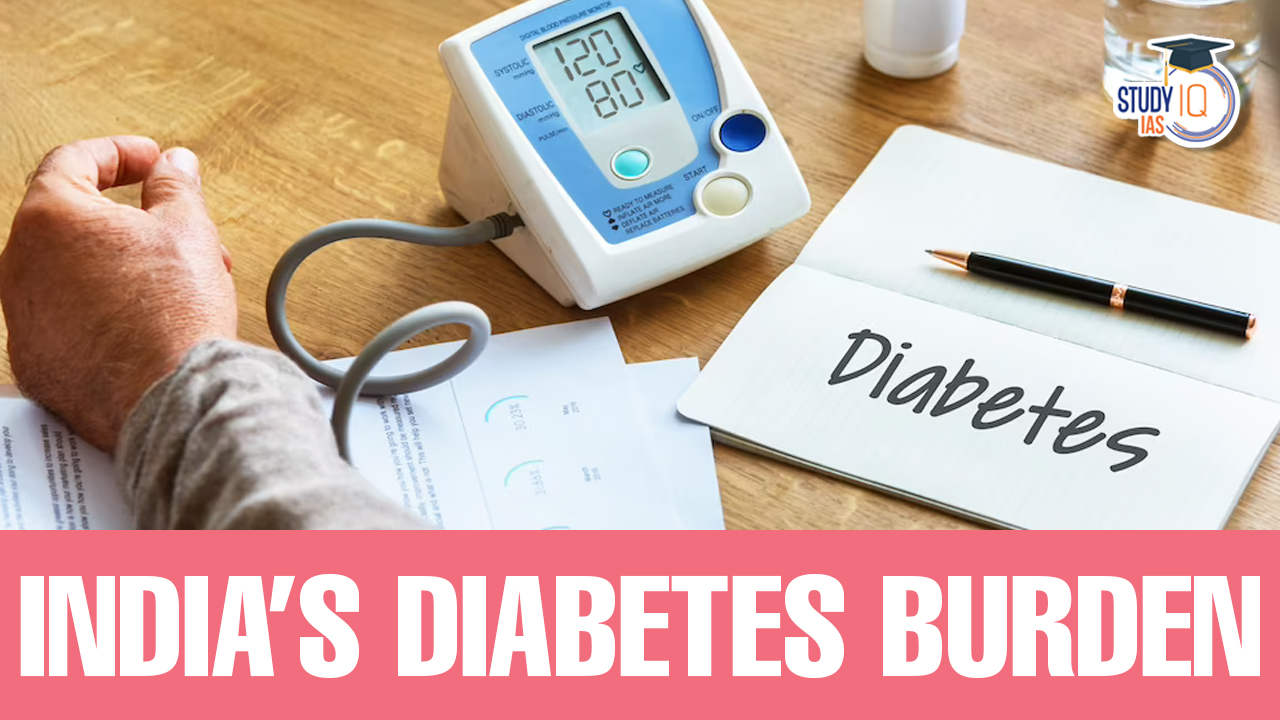Table of Contents
Context: The results of the largest and long-term study on metabolic factors in Indian subcontinent was published in The Lancet recently.
More on the News
- The study is the ICMR-InDiab study, which is the largest long-term study on metabolic factors conducted in the Indian subcontinent contributing to a better understanding of the country’s health challenges.
- It was launched in 2008 with the objective of estimating the burden of chronic non-communicable diseases (NCDs) such as diabetes, obesity, and cardiovascular health in India.
- The study was conducted over five phases between 2008 and 2020, covering different regions of the country.
- Each phase of the study included five states, and all seven northeastern states were covered in one phase.
Key Findings of the Study
- Diabetes Prevalence: The study estimated that approximately 11% of the Indian population is diabetic. This translates to around 101.3 million people in the country having diabetes.
- Pre-diabetes Prevalence: The study also found that 15.3% of the population is in the pre-diabetic stage. This indicates that there are approximately 136 million people in India at risk of developing diabetes.
- Window of Opportunity for Prevention: Prevention is crucial in managing metabolic lifestyle disorders. The study emphasizes the importance of seizing the window of opportunity to prevent complications and the progression from pre-diabetes to diabetes. Public awareness campaigns and mass education on lifestyle modifications can help control blood sugar levels, prevent complications, and promote healthier living.
- Emergent Crisis: The high prevalence of diabetes and pre-diabetes raises concerns about the emergence of a health crisis in India. There is an urgency of methods that need to be employed to address this situation and control the potential increase in these numbers in the future.
- Prevalence in Different Regions: The study found that the prevalence of diabetes and pre-diabetes was not limited to metro cities but was also growing in 2-3 tier cities. In Kerala, even rural areas showed a higher prevalence compared to urban areas. The northeastern states of Tripura and Sikkim also exhibited higher prevalence rates.
- Global Comparison: According to the World Health Organization (WHO), approximately 422 million people worldwide have diabetes, and 1.5 million deaths are directly attributed to the disease each year.
- The increasing number of cases and the prevalence of diabetes globally necessitate efforts to halt the rise in diabetes and obesity by 2025, as agreed upon globally.
- Hypertension: The prevalence of hypertension or high blood pressure was found to be higher still in the country. Around 35.5% of the population or 315 million people are living with the condition as per the study.
- Obesity: In addition to BMI (body mass index) that is generally used as a measure for obesity, the Indiab researchers looked at abdominal or central obesity. This is because Indians tend to gather fat in the abdominal region and despite the BMI being normal people might be at a higher risk of diseases of obesity.
- The study found that 28.6% of the population would be considered to be obese as per the BMI measure, 39.5% of the population or 351 million people had abdominal obesity.
- Hypercholesterolemia: The study also found that 24% of the population or 213 million people were living with hypercholesterolemia — a condition where the bad cholesterol or LDL levels are high.

Implications of the Study
The study indicate the significance of addressing metabolic lifestyle disorders, particularly diabetes, in India.
- Prevention as the Key: The result emphasizes the importance of prevention in managing metabolic lifestyle disorders. With proper attention and preventive measures, it is possible to avoid severe complications and maintain a better quality of life. This is crucial for the 136 million individuals in the pre-diabetic stage to prevent their progression to diabetes.
- Urgency for Prevention: By prioritizing prevention, the aim is to prevent life-threatening complications in individuals with diabetes and hinder the progress from pre-diabetes to diabetes. In rural areas, where the prevalence is relatively lower, efforts should be made to maintain the current status.
- Impact of Poor Blood Sugar Control: Poor control of blood sugar can lead to various complications, including cardiovascular disease, kidney disease, neuropathy, blindness, and lower-extremity amputation. These complications contribute to increased morbidity and mortality rates. While ensuring sufficient facilities for treating complications is important, a sagacious approach involves launching public awareness campaigns to promote lifestyle modifications that help maintain acceptable blood sugar levels and prevent complications.
- Conversion from Pre-diabetes to Diabetes: The study reveals a concerning phenomenon observed during the research, where the conversion from pre-diabetes to diabetes was faster in India, sometimes occurring within six months. This highlights the need for immediate attention to promoting healthy lifestyles that can slow down or prevent the progression to diabetes.
- Regional Disparities: The statistics show variations in prevalence between urban and rural areas, with urban areas having a higher prevalence. However, experts emphasize the importance of prevention in both settings. As traditional lifestyles shift to more modern practices, maintaining a healthy diet, engaging in sufficient exercise, and undergoing periodic testing for those at risk become essential.
- Importance of Screening Programs: Periodic epidemiological screening programs are considered vital to identify new cases of diabetes and ensure early intervention. These programs play a crucial role in capturing individuals with diabetes and bringing them into the protective healthcare system.
What is Diabetes?
- Diabetes is a chronic Non communicable condition characterized by elevated levels of blood sugar (glucose) due to the body’s inability to properly produce or use insulin. Insulin is a hormone produced by the pancreas that helps regulate blood sugar levels.
Types of Diabetes
There are several types of diabetes, including:
- Type 1 Diabetes (T1D):
- This type typically occurs in children and young adults, although it can develop at any age. It is an autoimmune disorder in which the immune system mistakenly attacks and destroys the insulin-producing cells in the pancreas.
- The exact cause is unknown, but genetic and environmental factors are believed to play a role.
- Treatment for type 1 diabetes involves insulin injections or the use of an insulin pump to manage blood sugar levels.
- Type 2 Diabetes (T2D):
- This form of diabetes occurs when the body becomes resistant to the effects of insulin or fails to produce enough insulin to maintain normal blood sugar levels.
- It is often associated with lifestyle factors such as obesity, physical inactivity, and poor diet.
- Type 2 diabetes can occur at any age, but it is more common in middle-aged and older individuals.
- Treatment for type 2 diabetes includes lifestyle modifications (such as a healthy diet and regular exercise), oral medications, and, in some cases, insulin therapy.
- Gestational Diabetes:
- This type of diabetes develops during pregnancy in some women.
- It occurs when hormonal changes during pregnancy lead to insulin resistance, resulting in high blood sugar levels.
- Gestational diabetes usually resolves after giving birth, but it increases the risk of developing type 2 diabetes later in life.
- Treatment involves dietary changes, physical activity, and, in some cases, insulin therapy.
Common symptoms of diabetes, regardless of the type, include increased thirst, frequent urination, unexplained weight loss, fatigue, blurred vision, slow healing of wounds, and recurrent infections.
Government Initiatives
The Government of India has taken several initiatives to tackle diabetes and promote better management of the condition.
- National Programme for Prevention and Control of Cancer, Diabetes, Cardiovascular Diseases, and Stroke (NPCDCS): This national program was launched in 2010 by the Ministry of Health and Family Welfare to prevent and control non-communicable diseases (including diabetes) at the primary healthcare level. It focuses on health promotion, early diagnosis, and management of diabetes through various interventions such as screening, awareness campaigns, and capacity building of healthcare providers.
- National Health Mission (NHM): NHM, launched in 2013, aims to provide accessible, affordable, and quality healthcare to all. Under NHM, various programs and initiatives are implemented to address non-communicable diseases, including diabetes. These initiatives focus on strengthening healthcare infrastructure, promoting preventive healthcare, and ensuring availability of essential medicines and diagnostics for diabetes management.
- Pradhan Mantri Surakshit Matritva Abhiyan (PMSMA): PMSMA is a maternity benefit program launched in 2016 to ensure comprehensive antenatal care to pregnant women. As part of this program, screening and management of gestational diabetes are included to promote the early detection and appropriate management of diabetes during pregnancy.
- Ayushman Bharat – Pradhan Mantri Jan Arogya Yojana (PM-JAY): PM-JAY, launched in 2018, is a national health insurance scheme that aims to provide financial protection to economically vulnerable populations. The scheme covers the treatment and management of diabetes, including hospitalization expenses and access to essential medications.
- Eat Right India: This initiative was launched by the Food Safety and Standards Authority of India (FSSAI) to promote healthier eating habits and lifestyles. It includes campaigns and programs to raise awareness about the importance of a balanced diet, physical activity, and the prevention of diet-related diseases, including diabetes.
- National Diabetes and Diabetic Retinopathy Survey: The central government, in collaboration with state governments, has conducted nationwide surveys to assess the burden of diabetes and diabetic retinopathy. These surveys provide valuable data for policymakers to design targeted interventions and allocate resources effectively.
- Global Diabetes Compact:
- The Global Diabetes Compact has the vision of reducing the risk of diabetes, and ensuring that all people who are diagnosed with diabetes have access to equitable, comprehensive, affordable and quality treatment and care.
- A key aim of the program is to unite key stakeholders from the public and private sectors, and, critically, people who live with diabetes, around a common agenda, to generate new momentum and co-create solutions.


 How African Reserves Eliminated Rhino Po...
How African Reserves Eliminated Rhino Po...
 Why India Needs Its Own Economic Model?
Why India Needs Its Own Economic Model?
 Challenges in India’s Airline Sector: ...
Challenges in India’s Airline Sector: ...

























